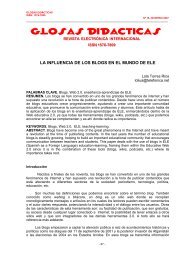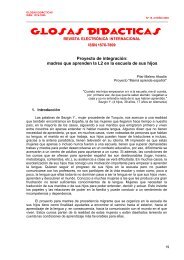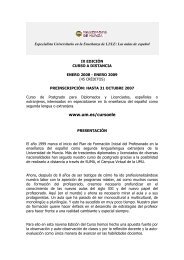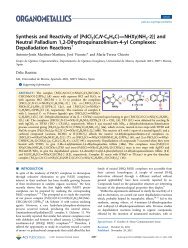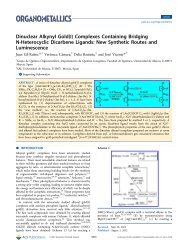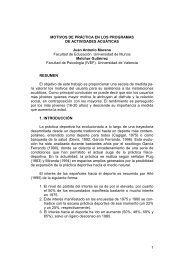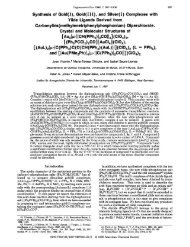Synthesis and luminescence of poly (phenylacetylene) s with ...
Synthesis and luminescence of poly (phenylacetylene) s with ...
Synthesis and luminescence of poly (phenylacetylene) s with ...
Create successful ePaper yourself
Turn your PDF publications into a flip-book with our unique Google optimized e-Paper software.
<strong>Synthesis</strong> <strong>and</strong> Luminescence <strong>of</strong> Poly(<strong>phenylacetylene</strong>)s <strong>with</strong> Pendant<br />
Iridium Complexes <strong>and</strong> Carbazole Groups<br />
JOSÉ VICENTE, 1 JUAN GIL-RUBIO, 1 GUIJIANG ZHOU, 1 * HENK J. BOLINK, 2 JOAQUÍN ARIAS-PARDILLA 3<br />
1 Grupo de Química Organometálica, Departamento de Química Inorgánica, Facultad de Química,<br />
Universidad de Murcia, Murcia E–30071, Spain<br />
2 Instituto de Ciencia Molecular (ICMol), Universidad de Valencia, P.O. Box 22085, 46071 Valencia, Spain<br />
3 Centre for Electrochemistry <strong>and</strong> Intelligent Materials (CEMI), Universidad Politécnica de Cartagena,<br />
ETSII, E-30203, Cartagena, Spain<br />
Received 29 March 2010; accepted 25 May 2010<br />
DOI: 10.1002/pola.24159<br />
Published online in Wiley InterScience (www.interscience.wiley.com).<br />
ABSTRACT: Poly(<strong>phenylacetylene</strong>)s containing pendant phosphorescent<br />
iridium complexes have been synthesized <strong>and</strong> their<br />
electrochemical, photo- <strong>and</strong> electroluminescent properties studied.<br />
The <strong>poly</strong>mers have been synthesized by rhodium-catalyzed<br />
co<strong>poly</strong>merization <strong>of</strong> 9-(4-ethynylphenyl)carbazole (CzPA) <strong>and</strong><br />
<strong>phenylacetylene</strong>s (C^N) 2 Ir(j 2 -O,O 0 -MeC(O)CHC(O)C 6 H 4 CBCH-4)<br />
(C^N ¼ j 2 -N,C 1 -2-(pyridin-2-yl)phenyl (Ir ppy PA) or j 2 -N,C 1 -2-(isoquinolin-1-yl)phenyl<br />
(Ir piq PA)). In addition, organic <strong>poly</strong>(<strong>phenylacetylene</strong>)s<br />
<strong>with</strong> pendant carbazole groups have been<br />
synthesized by rhodium-catalyzed co<strong>poly</strong>merization <strong>of</strong> CzPA<br />
<strong>and</strong> 1-ethynyl-4-pentylbenzene. Complex (C^N) 2 Ir(j 2 -O,O 0 -<br />
MeC(O)CHC(O)Ph) (Ir piq Ph; C^N ¼ 2-(isoquinolin-1-yl)phenyl-j 2 -<br />
N,C 1 ) was prepared <strong>and</strong> characterized. While the co<strong>poly</strong>mers <strong>of</strong><br />
the Ir ppy series were weakly phosphorescent, those <strong>of</strong> the Ir piq<br />
series displayed at room temperature intense emissions from the<br />
carbazole (fluorescence) <strong>and</strong> iridium (phosphorescence) emitters,<br />
being the latter dominant when the spectra were recorded using<br />
<strong>poly</strong>mer films. Triple layer OLED devices employing co<strong>poly</strong>mers<br />
<strong>of</strong> the Ir piq series or the model complex Ir piq Ph yielded electro<strong>luminescence</strong><br />
<strong>with</strong> an emission spectra originating from the<br />
iridium complex <strong>and</strong> maximum external quantum efficiencies <strong>of</strong><br />
0.46% <strong>and</strong> 2.99%, respectively. VC 2010 Wiley Periodicals, Inc.<br />
J Polym Sci Part A: Polym Chem 48: 3744–3757, 2010<br />
KEYWORDS: electrochemistry; iridium complexes; metal-<strong>poly</strong>mer<br />
complexes; photophysics; <strong>poly</strong>acetylenes<br />
INTRODUCTION Transition-metal catalyzed <strong>poly</strong>merization <strong>of</strong><br />
alkynes has led to a pr<strong>of</strong>usion <strong>of</strong> <strong>poly</strong>mers ranging from<br />
<strong>poly</strong>acetylene to sophisticated functional <strong>poly</strong>mers. 1–4 The<br />
groups attached to the conjugated backbone not only afford<br />
functionality to the <strong>poly</strong>mer, but also determine the conformation<br />
<strong>and</strong> degree <strong>of</strong> conjugation <strong>of</strong> the main chain. 3,5–11 In<br />
consequence, by adequate choice <strong>of</strong> the substituents <strong>of</strong> the<br />
starting alkyne, <strong>poly</strong>acetylenes can be endowed <strong>with</strong> interesting<br />
physico-chemical properties, for example, gas permeability,<br />
photoconductivity, liquid crystallinity, photo- <strong>and</strong><br />
electro<strong>luminescence</strong>, optical nonlinearity, chromism or chiral<br />
recognition. 1–3,12–14<br />
The attachment <strong>of</strong> metal complexes to conjugated <strong>poly</strong>mers<br />
is recognized as a way to produce new materials <strong>with</strong><br />
properties that result <strong>of</strong> the combination <strong>of</strong> the redox or<br />
photophysical activity <strong>of</strong> the metal complexes <strong>with</strong> those <strong>of</strong><br />
the unsaturated backbone. 15–18 In particular, <strong>poly</strong>acetylenes<br />
containing phosphorescent transition-metal complexes<br />
attached to the main chain are potential c<strong>and</strong>idates to present<br />
interesting electrooptical properties. Surprisingly, very<br />
few <strong>poly</strong>acetylenes <strong>with</strong> pendant metal complexes have been<br />
described. Among them, the most studied are <strong>poly</strong>(ethynylferrocene)<br />
or <strong>poly</strong>(ethynylrutenocene). 19–28 Other metallo<strong>poly</strong>acetylenes<br />
reported are <strong>poly</strong>(<strong>phenylacetylene</strong>)s bearing<br />
Zn phorphirine 29 or Ru tris(imine) 30 complexes. We have<br />
reported <strong>poly</strong>acetylenes <strong>with</strong> pendant 2,2 0 -bipyridin-5-<br />
yl(bpyl) donor groups <strong>and</strong> their derivatives resulting <strong>of</strong> coordination<br />
<strong>of</strong> the bpyl group to Ru(bpy) 2þ<br />
2 or Mo(CO) 4 metal<br />
centers. 31<br />
Doping conjugated <strong>poly</strong>mers <strong>with</strong> phosphorescent heavymetal<br />
complexes is used to improve the electro<strong>luminescence</strong><br />
efficiency <strong>of</strong> <strong>poly</strong>mer electroluminescent devices (PLEDs). As<br />
in these systems both singlet <strong>and</strong> triplet excitons are captured,<br />
the internal efficiency <strong>of</strong> the devices can approach a<br />
theoretical value <strong>of</strong> 100%. 32–35 Recent studies have demonstrated<br />
that covalent binding <strong>of</strong> the heavy-metal complexes<br />
to the <strong>poly</strong>mer backbone may improve remarkably the electroluminescent<br />
performance <strong>of</strong> these materials. 13 Following<br />
this approach, Ir, 36–57 Pt 52,58,59 or Re 60 complexes have been<br />
incorporated in <strong>poly</strong>fluorenes, <strong>poly</strong>(p-phenylene)s, <strong>poly</strong>carbazoles<br />
or <strong>poly</strong>olefins as part <strong>of</strong> the main chain or as subsituents<br />
in side chains. Some <strong>of</strong> these organometallic <strong>poly</strong>mers<br />
*Present address: Department <strong>of</strong> Chemistry, Faculty <strong>of</strong> Science, Xi’an Jiao Tong University, Xi’an 710049, People’s Republic <strong>of</strong> China.<br />
Correspondence to: J. Gil-Rubio (E-mail: jgr@um.es) or G. Zhou (E-mail: zhougj@mail.xjtu.edu.cn)<br />
Journal <strong>of</strong> Polymer Science: Part A: Polymer Chemistry, Vol. 48, 3744–3757 (2010) VC 2010 Wiley Periodicals, Inc.<br />
3744 INTERSCIENCE.WILEY.COM/JOURNAL/JPOLA
ARTICLE<br />
Materials<br />
[Ir(piq)(l–Cl)] 2 (piq ¼ j 2 -N,C 1 -2-(isoquinolin-1-yl)phenyl), 92<br />
Ir ppy PA, 93 Ir piq PA 93 <strong>and</strong> [Rh(l–OMe)(NBD)] 2 (NBD ¼ norbornadiene),<br />
94 were prepared using reported methods. Other<br />
reagents were obtained from commercial sources <strong>and</strong> used<br />
<strong>with</strong>out further purification. THF was distilled over sodiumbenzophenone<br />
ketyl, <strong>and</strong> CH 2 Cl 2 was distilled over CaH 2 .All<br />
reactions were carried out under an inert atmosphere <strong>of</strong><br />
nitrogen at room temperature unless otherwise stated. The<br />
<strong>poly</strong>meric samples for elemental analysis were purified by<br />
reprecipitation <strong>and</strong> dried in a vacuum oven.<br />
CHART 1 Structures <strong>of</strong> the organometallic <strong>phenylacetylene</strong>s.<br />
exhibit an outst<strong>and</strong>ing performance as the emitting layer in<br />
PLEDs.<br />
Polyacetylenes derived from monosubstituted alkynes<br />
present in general very weak <strong>luminescence</strong>. 2,61–63 However,<br />
fluorescent <strong>poly</strong>acetylenes have been obtained by attaching<br />
fluorophores such are carbazole, 64–68 fluorene, 61,69 4-ethynylphenyl,<br />
70 bi- or terphenyl, 71,72 antryl, 73–75 phenantryl, 74<br />
pyrenyl 76 or silole 77 to the side chains. Some <strong>of</strong> these<br />
<strong>poly</strong>mers present electro<strong>luminescence</strong>. 64,70 In contrast, <strong>poly</strong><br />
(disubstituted alkyne)s present stronger fluoro- <strong>and</strong> electro<strong>luminescence</strong><br />
than those derived from monosubstituted<br />
alkynes. 1,2,13,61,63,78–89 Unfortunately, the <strong>poly</strong>merization <strong>of</strong><br />
disubstituted alkynes is limited to alkynes containing functional<br />
groups which are compatible <strong>with</strong> the highly reactive<br />
early-transition metal catalysts used. 3,90,91<br />
In this work we describe the synthesis <strong>of</strong> the first <strong>poly</strong>(<strong>phenylacetylene</strong>)s<br />
containing pendant Ir(III) complexes. These<br />
<strong>poly</strong>mers have been prepared by (i) <strong>poly</strong>merization <strong>of</strong><br />
<strong>phenylacetylene</strong>s Ir ppy PA or Ir piq PA (Chart 1) or (ii) co<strong>poly</strong>merization<br />
<strong>of</strong> these organometallic <strong>phenylacetylene</strong>s <strong>with</strong><br />
9-(4-ethynylphenyl)carbazole. All the <strong>poly</strong>mers have been<br />
characterized <strong>and</strong> their electrochemical, photophysical <strong>and</strong><br />
electroluminescent properties studied as well. These <strong>poly</strong>mers<br />
are, to the best <strong>of</strong> our knowledge, the first <strong>poly</strong>acetylenes<br />
reported showing metal-based phosphorescence.<br />
EXPERIMENTAL<br />
9-(4-Bromophenyl)carbazole<br />
A mixture <strong>of</strong> carbazole (500 mg, 2.99 mmol), 4-bromoiodobenzene<br />
(930 mg, 3.29 mmol), CuI (570 mg, 2.98 mmol),<br />
1,10-phenanthroline (580 mg, 2.93 mmol) <strong>and</strong> KOH<br />
(750 mg, 13.4 mmol) in p-xylene (25 mL) was stirred at ca.<br />
140 C for two days under nitrogen. The resulting suspension<br />
was filtered <strong>and</strong> CH 2 Cl 2 (80 mL) was added to the filtrate.<br />
The organic solution was washed <strong>with</strong> water <strong>and</strong> dried<br />
over MgSO 4 . After removing the solvent, the crude product<br />
was purified on a silica gel column <strong>with</strong> n-hexane/CH 2 Cl 2<br />
(5:1 v/v) as eluent. Evaporation <strong>of</strong> the solvent gave colorless<br />
crystals (620 mg, Yield: 64%). Mp 149–150 C.<br />
1 H NMR (300 MHz, CDCl 3 , d, ppm): 8.13 (d, J ¼ 7.8 Hz, 2H,<br />
Ar), 7.72 (d, J ¼ 8.7 Hz, 2H, Ar), 7.44 (d, J ¼ 8.7 Hz, 2H, Ar),<br />
7.41–7.34 (m, 4H, Ar), 7.31–7.24 (m, 2H, Ar).<br />
13 C{ 1 H} NMR<br />
(100 MHz, CDCl 3 , d, ppm): 140.6, 136.8, 133.1, 128.7, 126.1,<br />
123.5, 120.9, 120.4, 120.2, 109.5 (Ar). Anal. Calcd. for<br />
C 18 H 12 BrN: C 67.10, H 3.75, N 4.35. Found: C 66.81, H 3.71,<br />
N 4.42. The spectroscopic data <strong>of</strong> the compound agree <strong>with</strong><br />
those previously reported. 95,96<br />
9-(4-(2-trimethylsilylethynyl)Phenyl)carbazole<br />
9-(4-bromophenyl)carbazole (500 mg, 1.55 mmol), CuI<br />
(20 mg, 0.11 mmol) <strong>and</strong> [PdCl 2 (PPh 3 ) 2 ] (20 mg, 0.028<br />
mmol) were added to Et 3 N (20 mL) under nitrogen. Then<br />
ethynyltrimethylsilane (0.5 mL, 3.5 mmol) was added to the<br />
mixture. The reaction mixture was stirred at room temperature<br />
for 30 min <strong>and</strong> then heated at 80 C overnight. The<br />
resulting suspension was filtered <strong>and</strong> the filtrate was evaporated<br />
to dryness. The crude was purified on a silica gel<br />
column <strong>with</strong> n-hexane/CH 2 Cl 2 (6:1 v/v) as eluent. Evaporation<br />
<strong>of</strong> the solvent gave colorless crystals (421 mg, Yield:<br />
80%). Mp 150–152 C.<br />
1 H NMR (200 MHz, CDCl 3 , d, ppm): 8.17–8.12 (m, 2H, Ar),<br />
7.73–7.69 (m, 2H, Ar), 7.56–7.51 (m, 2H, Ar), 7.43–7.40 (m,<br />
4H, Ar), 7.34–7.28 (m, 2H, Ar), 0.31 (s, 9H, TMS).<br />
13 C{ 1 H}<br />
NMR (100 MHz, CDCl 3 , d, ppm): 140.5, 137.7, 133.5, 126.7,<br />
126.0, 123.5, 122.1, 120.4, 120.2, 109.7 (Ar), 104.2, 95.4<br />
(CBC), 0.1 (TMS). IR (KBr, cm –1 ): m(CBC) 2159. Anal. Calcd.<br />
for C 23 H 21 NSi: C 81.37, H 6.23, N 4.13. Found: C 81.14, H<br />
6.56, N 4.23.<br />
CzPA<br />
9-(4-(2-Trimethylsilylethynyl)phenyl)carbazole (420 mg, 1.24<br />
mmol) was dissolved in MeOH/THF (15 mL, 1:1 v/v) under<br />
nitrogen. Then 1 N KOH in H 2 O (1.4 mL) was added to the<br />
mixture. The reaction mixture was stirred at room temperature<br />
for about 30 min. Then the solvent was removed <strong>and</strong><br />
the residue was extracted <strong>with</strong> CH 2 Cl 2 (100 mL). The organic<br />
SYNTHESIS AND LUMINESCENCE OF POLY(PHENYLACETYLENE)s, VICENTE ET AL. 3745
JOURNAL OF POLYMER SCIENCE: PART A: POLYMER CHEMISTRY DOI 10.1002/POLA<br />
solution was washed <strong>with</strong> water (3 100 mL) <strong>and</strong> dried<br />
over MgSO 4 . After removing the solvent, the product was<br />
recrystallized from CH 2 Cl 2 <strong>and</strong> n-pentane to give colorless<br />
crystals (298 mg, Yield: 90%). Mp 106–107 C.<br />
1 H NMR (200 MHz, CDCl 3 , d, ppm): 8.17–8.14 (m, 2H, Ar),<br />
7.75–7.73 (m, 2H, Ar), 7.57–7.55 (m, 2H, Ar), 7.44–7.42 (m,<br />
4H, Ar), 7.33–7.29 (m, 2H, Ar), 3.19 (s, 1H, CBCH).<br />
13 C{ 1 H}<br />
NMR (100 MHz, CDCl 3 , d, ppm): 140.5, 138.1, 133.7, 126.8,<br />
126.1, 123.6, 121.0, 120.4, 120.3, 109.7, 82.9 (CBC), 78.1<br />
(CBC). IR (KBr, cm –1 ): m(BC–H) 3262, m(CBC) 2106. Anal.<br />
Calcd. for C 20 H 13 N: C 89.86, H 4.90, N 5.24. Found: C 89.56,<br />
H 4.86, N 5.29. The spectroscopic data <strong>of</strong> the compound<br />
agree <strong>with</strong> those previously reported. 97<br />
PIr ppy PA<br />
Under nitrogen atmosphere, Ir ppy PA (100 mg, 0.15 mmol),<br />
PPh 3 (1 mg, 0.0038 mmol) <strong>and</strong> DMAP (2 mg, 0.016 mmol)<br />
were dissolved in THF (10 mL). Then [Rh(l–OMe)(NBD)] 2<br />
(2 mg, 0.0044 mmol) was added <strong>and</strong> the reaction mixture<br />
was stirred overnight at room temperature. Then, the solvent<br />
was removed under reduced pressure <strong>and</strong> the residue<br />
dissolved in CH 2 Cl 2 (ca. 2 mL). The solution was added dropwise<br />
to vigorously stirred methanol (30 mL), <strong>and</strong> the resulting<br />
orange precipitate was collected by centrifugation,<br />
washed <strong>with</strong> methanol (3 20 mL) <strong>and</strong> dried under<br />
vacuum to give an orange solid (70 mg, Yield: 70%).<br />
1 H NMR (200 MHz, CD 2 Cl 2 , d, ppm): 8.31 (m, br, Ar), 8.00–<br />
5.80 (m, br, Ar, <strong>and</strong> C¼CH), 5.45 (s, br, COCHCO), 2.00–1.30<br />
(s, br, Me). Anal. Calcd. for [C 34 H 25 IrN 2 O 2 ] n : C 59.55, H 3.67,<br />
N 4.08. Found: C 58.55, H 3.56, N 3.97.<br />
PIr ppy CzPA1<br />
Under nitrogen atmosphere, Ir ppy PA (100 mg, 0.15 mmol),<br />
CzPA (8 mg, 0.030 mmol), PPh 3 (1 mg, 0.0038 mmol) <strong>and</strong><br />
DMAP (2 mg, 0.016 mmol) were dissolved in THF (10 mL).<br />
Then [Rh(l–OMe)(NBD)] 2 (2 mg, 0.0044 mmol) was added<br />
<strong>and</strong> the reaction mixture was stirred overnight at room temperature.<br />
Then, the solution was concentrated under reduced<br />
pressure up to about 2 mL <strong>and</strong> added dropwise to<br />
vigorously stirred methanol (30 mL). The orange precipitate<br />
was collected by centrifugation, washed <strong>with</strong> methanol (3 <br />
20 mL) <strong>and</strong> dried under vacuum, to give an orange solid<br />
(100 mg, Yield: 93%).<br />
1 H NMR (300 MHz, CD 2 Cl 2 , d, ppm): 8.60–5.00 (m, br, Ar,<br />
C¼CH <strong>and</strong> COCHCO), 2.00–1.20 (br, Me). Anal. Calcd. for<br />
[(C 34 H 25 IrN 2 O 2 ) 0.95 (C 20 H 13 N) 0.05 ] n : C 60.16, H 3.70, N 4.11.<br />
Found: C 60.47, H 3.79, N 4.08.<br />
PIr ppy CzPA2<br />
It was prepared from Ir ppy PA (77 mg, 0.11 mmol), CzPA<br />
(150 mg, 0.56 mmol), PPh 3 (3 mg, 0.011 mmol), DMAP<br />
(6 mg, 0.049 mmol) <strong>and</strong> [Rh(l–OMe)(NBD)] 2 (3 mg, 0.0066<br />
mmol) in THF (10 mL), following the same procedure as for<br />
PIr ppy CzPA1. The <strong>poly</strong>mer was obtained as an orange solid<br />
(210 mg, Yield: 93%).<br />
1 H NMR (300 MHz, CDCl 3 , d, ppm): 8.60–5.00 (m, br, Ar,<br />
C¼CH <strong>and</strong> COCHCO), 2.00–1.10 (s, br, Me). Anal. Calcd. for<br />
[(C 34 H 25 IrN 2 O 2 ) 0.18 (C 20 H 13 N) 0.82 ] n : C 78.94, H 4.46, N 4.82.<br />
Found: C 78.44, H 4.67, N 4.85.<br />
PIr ppy CzPA3<br />
It was prepared from Ir ppy PA (38.5 mg, 0.056 mmol), CzPA<br />
(150 mg, 0.56 mmol), PPh 3 (3 mg, 0.011 mmol), DMAP<br />
(6 mg, 0.049 mmol) <strong>and</strong> [Rh(l–OMe)(NBD)] 2 (3 mg, 0.0066<br />
mmol) in THF (10 mL), following the same procedure as for<br />
PIr ppy CzPA1. The <strong>poly</strong>mer was obtained as an orange solid<br />
(172 mg, Yield: 91%).<br />
1 H NMR (300 MHz, CDCl 3 , d, ppm): 8.60–5.40 (m, br, Ar,<br />
C¼CH <strong>and</strong> COCHCO), 2.00–1.30 (s, br, Me). Anal. Calcd. for<br />
[(C 34 H 25 IrN 2 O 2 ) 0.10 (C 20 H 13 N) 0.90 (H 2 O) 0.3 ] n : C 81.71, H 4.74,<br />
N 4.90. Found: C 81.96, H 4.79, N 4.95. Water could no be<br />
completely removed by drying in a vacuum oven.<br />
PIr ppy CzPA4<br />
It was prepared from Ir ppy PA (19 mg, 0.028 mmol), CzPA<br />
(150 mg, 0.56 mmol), PPh 3 (3 mg, 0.011 mmol), DMAP<br />
(6 mg, 0.049 mmol) <strong>and</strong> [Rh(l–OMe)(NBD)] 2 (3 mg,<br />
0.0066 mmol) in THF (10 mL), following the same procedure<br />
as for PIr ppy CzPA1. The <strong>poly</strong>mer was obtained as an orange<br />
solid (160 mg, Yield: 95%).<br />
1 H NMR (400 MHz, CDCl 3 , d, ppm): 8.60–5.30 (m, br, Ar,<br />
C¼CH <strong>and</strong> COCHCO), 2.10–1.30 (s, br, Me); Anal. Calcd. for<br />
[(C 34 H 25 IrN 2 O 2 ) 0.05 (C 20 H 13 N) 0.95 (H 2 O) 0.7 ] n : C 82.64, H 5.03,<br />
N 4.89. Found: C 82.53, H 4.67, N 4.93. Water could no be<br />
completely removed by drying in a vacuum oven.<br />
PIr piq PA<br />
It was prepared from Ir piq PA (118 mg, 0.15 mmol), PPh 3 (1<br />
mg, 0.0038 mmol), DMAP (2 mg, 0.016 mmol) <strong>and</strong> [Rh(l–<br />
OMe)(NBD)] 2 (2 mg, 0.0044 mmol) in THF (10 mL), following<br />
the same procedure as for PIr ppy CzPA1. The <strong>poly</strong>mer<br />
was obtained as an orange red solid (70 mg, Yield: 60%).<br />
1 H NMR (300 MHz, CDCl 3 , d, ppm): 8.90, 8.50, 8.15, 7.85,<br />
7.60, 7.35, 6.85, 6.60, 6.35 (several m, br, Ar), 5.80 (m, br,<br />
COCHCO), 1.85 (s, br, Me); the vinyl H signal could not be<br />
located due to its broadness. Anal. Calcd. for [C 42 H 29 Ir-<br />
N 2 O 2 ] n : C 64.19, H 3.72, N 3.56. Found: C 63.53, H 3.82,<br />
N 3.82.<br />
PIr piq CzPA1<br />
It was prepared from Ir piq PA (100 mg, 0.13 mmol), CzPA (7<br />
mg, 0.026 mmol), PPh 3 (1 mg, 0.0038 mmol), DMAP (2 mg,<br />
0.0044 mmol) <strong>and</strong> [Rh(l–OMe)(NBD)] 2 (2 mg, 0.0044 mmol)<br />
in THF (10 mL), following the same procedure as for PIr p-<br />
py CzPA1. The <strong>poly</strong>mer was obtained as an orange red solid<br />
(70 mg, Yield: 65%).<br />
1 H NMR (400 MHz, CDCl 3 , d, ppm): 8.90–5.00 (m, br, Ar,<br />
C¼CH <strong>and</strong> COCHCO), 2.00–1.20 (s, br, Me). Anal. Calcd. for<br />
[(C 42 H 29 IrN 2 O 2 ) 0.91 (C 20 H 13 N) 0.09 ] n : C 65.02, H 3.76, N 3.62.<br />
Found: C 64.60, H 4.05, N 3.75.<br />
PIr piq CzPA2<br />
It was prepared from Ir piq PA (100 mg, 0.13 mmol), CzPA<br />
(35 mg, 0.13 mmol), PPh 3 (2 mg, 0.0076 mmol), DMAP<br />
(4 mg, 0.033 mmol) <strong>and</strong> [Rh(l–OMe)(NBD)] 2 (4 mg, 0.0088<br />
mmol) in THF (10 mL), following the same procedure as for<br />
3746 INTERSCIENCE.WILEY.COM/JOURNAL/JPOLA
ARTICLE<br />
PIr ppy CzPA1. The <strong>poly</strong>mer was obtained as an orange red<br />
solid (116 mg, Yield: 86%).<br />
1 H NMR (400 MHz, CDCl 3 , d, ppm): 9.00–5.50 (m, br, Ar,<br />
C¼CH <strong>and</strong> COCHCO), 1.89 (s, br, Me). Anal. Calcd. for<br />
[(C 42 H 29 IrN 2 O 2 ) 0.68 (C 20 H 13 N) 0.32 ] n : C 67.73, H 3.88, N 3.80.<br />
Found: C 67.14, H 3.66, N 3.73.<br />
PIr piq CzPA3<br />
It was prepared from Ir piq PA (88 mg, 0.11 mmol), CzPA<br />
(150 mg, 0.56 mmol), PPh 3 (3 mg, 0.011 mmol), DMAP<br />
(6 mg, 0.049 mmol) <strong>and</strong> [Rh(l–OMe)(NBD)] 2 (3 mg, 0.0066<br />
mmol) in THF (10 mL), following the same procedure as for<br />
PIr ppy CzPA1. The <strong>poly</strong>mer was obtained as an orange solid<br />
(219 mg, Yield: 92%).<br />
1 H NMR (200 MHz, CDCl 3 , d, ppm): 8.90–5.00 (m, br, Ar,<br />
C¼CH <strong>and</strong> COCHCO), 2.00–1.40 (s, br, Me). Anal. Calcd. for<br />
[(C 42 H 29 IrN 2 O 2 ) 0.18 (C 20 H 13 N) 0.82 ] n : C 79.79, H 4.44, N 4.58.<br />
Found: C 79.76, H 4.51, N 4.58.<br />
PIr piq CzPA4<br />
It was prepared from Ir piq PA (44 mg, 0.056 mmol), CzPA<br />
(150 mg, 0.56 mmol), PPh 3 (3 mg, 0.011 mmol), DMAP (6<br />
mg, 0.049 mmol) <strong>and</strong> [Rh(l–OMe)(NBD)] 2 (3 mg, 0.0066<br />
mmol) in THF (10 mL), following the same procedure as for<br />
PIr ppy CzPA1. The <strong>poly</strong>mer was obtained as an orange solid<br />
(189 mg, Yield: 97%).<br />
1 H NMR (300 MHz, CDCl 3 , d, ppm): 8.90–5.00 (m, br, Ar,<br />
C¼CH <strong>and</strong> COCHCO), 2.00–1.20 (s, br, Me). Anal. Calcd. for<br />
[(C 42 H 29 IrN 2 O 2 ) 0.09 (C 20 H 13 N) 0.91 ] n : C 84.08, H 4.64, N 4.86.<br />
Found: C 82.39, H 4.63, N 5.06.<br />
PIr piq CzPA5<br />
It was prepared from Ir piq PA (22 mg, 0.028 mmol), CzPA<br />
(150 mg, 0.56 mmol), PPh 3 (3 mg, 0.011 mmol), DMAP<br />
(6 mg, 0.049 mmol) <strong>and</strong> [Rh(l–OMe)(NBD)] 2 (3 mg, 0.0066<br />
mmol) in THF (10 mL), following the same procedure as for<br />
PIr ppy CzPA1. The <strong>poly</strong>mer was obtained as orange solid<br />
(162 mg, Yield: 94%); 1 H NMR (200 MHz, CDCl 3 , d, ppm):<br />
8.90–5.00 (m, br, Ar, C¼CH <strong>and</strong> COCHCO), 2.00–1.20 (s, br,<br />
Me). Anal. Calcd. for [(C 42 H 29 IrN 2 O 2 ) 0.05 (C 20 H 13 N) 0.95 ] n :<br />
C 86.42, H 4.74, N 5.02. Found: C 85.52, H 4.74, N 5.30.<br />
PCzArPA1<br />
It was prepared from CzPA (130 mg, 0.49 mmol), 1-ethynyl-<br />
4-n-pentylbenzene (84 mg, 0.49 mmol), PPh 3 (4 mg, 0.011<br />
mmol), DMAP (8 mg, 0.065 mmol) <strong>and</strong> [Rh(l–OMe)(NBD)] 2<br />
(4 mg, 0.0088 mmol) in THF (10 mL), following the same<br />
procedure as for PIr ppy CzPA1. The <strong>poly</strong>mer was obtained as<br />
a yellow solid (200 mg, Yield: 93%).<br />
1 H NMR (400 MHz, CDCl 3 , d, ppm): 7.96 (m, br, Ar), 7.50–<br />
5.60 (m, br, Ar <strong>and</strong> C¼CH), 2.60–2.00 (m, br, CH 2 Ar), 1.60–<br />
0.50 (m, br, (CH 2 ) 3 CH 3 ). Anal. Calcd. for [(C 20 H 13 N) 0.55 -<br />
(C 13 H 16 ) 0.45 ] n : C 90.13, H 6.44, N 3.43. Found: C 89.28, H<br />
6.69, N 3.49. The co-monomer ratio estimated from the<br />
integrals <strong>of</strong> the 1 H NMR spectrum was 0.5/0.5.<br />
PCzArPA2<br />
It was prepared from CzPA (100 mg, 0.37 mmol), 1-ethynyl-<br />
4-pentylbenzene (322 mg, 1.87 mmol), PPh 3 (8 mg, 0.031<br />
mmol), DMAP (16 mg, 0.13 mmol) <strong>and</strong> [Rh(l–OMe)(NBD)] 2<br />
(8 mg, 0.0177 mmol) in THF (10 mL), following the same<br />
procedure as for PIr ppy CzPA1. The <strong>poly</strong>mer was obtained as<br />
a bright yellow solid (200 mg, Yield: 47%).<br />
1 H NMR (200 MHz, CDCl 3 , d, ppm): 7.99–5.70 (m, br, Ar <strong>and</strong><br />
C¼CH), 2.60–2.00 (m, br, CH 2 Ar), 1.60–0.50 (m, br,<br />
(CH 2 ) 3 CH 3 ). Anal. Calcd. for [(C 20 H 13 N) 0.29 (C 13 H 16 ) 0.71 ] n : C<br />
90.34, H 7.63, N 2.03. Found: C 89.89, H 7.92, N 2.06. The<br />
co-monomer ratio estimated from the integrals <strong>of</strong> the 1 H<br />
NMR spectrum was 0.3/0.7.<br />
PCzPA<br />
Under a nitrogen atmosphere, CzPA (150 mg, 0.56 mmol),<br />
PPh 3 (3 mg, 0.011 mmol) <strong>and</strong> DMAP (6 mg, 0.049 mmol)<br />
were dissolved in THF (10 mL). Then [Rh(l–OMe)(NBD)] 2<br />
(3 mg, 0.0066 mmol) was added <strong>and</strong> the reaction mixture<br />
was stirred overnight at room temperature. Then, the reaction<br />
mixture was poured into vigorously stirred methanol<br />
(40 mL). The suspension was centrifugated <strong>and</strong> the deep-red<br />
solid was washed <strong>with</strong> methanol (3 25 mL) <strong>and</strong> dried<br />
under vacuum (140 mg, Yield: 93%). Anal. Calcd. for<br />
[(C 20 H 13 N)(H 2 O) 0.35 ] n C 87.79, H 5.05, N 5.12. Found: C 87.73,<br />
H 5.08, N 5.23. The NMR spectra could not be recorded due to<br />
the poor solubility <strong>of</strong> the <strong>poly</strong>mer.<br />
Ir piq Ph<br />
A suspension <strong>of</strong> [Ir(piq)(l–Cl)] 2 (100 mg, 0.079 mmol),<br />
benzoylacetone (19 mg, 0.12 mmol) <strong>and</strong> Na 2 CO 3 (84 mg,<br />
0.79 mmol) in 2-ethoxylethanol (10 mL) was stirred at ca.<br />
110 C overnight under nitrogen. Water (40 mL) was added<br />
after cooling to room temperature. The red precipitate was<br />
collected by filtration <strong>and</strong> extracted <strong>with</strong> CH 2 Cl 2 (60 mL).<br />
The extract was dried over MgSO 4 , the solution evaporated<br />
to dryness <strong>and</strong> the crude product was purified by column<br />
chromatography on silica using n-hexane/CH 2 Cl 2 (1:3 v/v) as<br />
eluent. Evaporation <strong>of</strong> the resulting solution gave a red solid<br />
(90 mg, Yield: 75%). Mp 285–288 C.<br />
1 H NMR (300 MHz, CDCl 3 , d, ppm): 9.01 (m, 2H, piq <strong>and</strong> piq 0<br />
H8), 8.52 (d, J ¼ 6.4 Hz, 1H, piq 0 H3), 8.49 (d, J ¼ 6.4 Hz,<br />
1H, piq H3), 8.23 (d, J ¼ 8.0 Hz, 1H, piq 0 C 6 H 4 H6), 8.22 (d,<br />
J ¼ 8.0 Hz, 1H, piq C 6 H 4 H6), 7.92–7.88 (m, 2H, piq <strong>and</strong> piq 0<br />
H5), 7.72–7.66 (m, 6H, piq <strong>and</strong> piq 0 H6 <strong>and</strong> H7, C 6 H 5 H2),<br />
7.45 (d, J ¼ 6.5 Hz, 1H, piq 0 H4), 7.41 (d, J ¼ 6.4 Hz, 1H, piq<br />
H4), 7.32 (m, 1H, C 6 H 5 H4), 7.21 (m, 2H, C 6 H 5 H3), 6.95–<br />
6.89 (m, 2H, piq <strong>and</strong> piq 0 C 6 H 4 H5), 6.71–6.66 (m, 2H, piq<br />
<strong>and</strong> piq 0 C 6 H 4 H4), 6.44 (d, J ¼ 7.6 Hz, 2H, piq <strong>and</strong> piq 0 C 6 H 4<br />
H3), 5.89 (s, 1H, COCHCO), 1.89 (s, 3H, Me);<br />
13 C NMR<br />
(100 MHz, CDCl 3 , d, ppm): 186.7 (CO), 177.5 (CO), 169.42,<br />
169.37, 152.21, 152.15, 146.7, 140.9, 140.74, 140.68, 137.3,<br />
134.9, 133.9, 130.7, 130.1, 129.9, 129.7, 129.2, 128.9, 128.2,<br />
127.7, 127.4, 127.0, 126.5, 120.6, 120.4, 120.0, 97.7<br />
(COCHCO), 29.7 (Me). HRMS (EI, m/z): Calcd. for C 40 H 29 -<br />
IrN 2 O 2 762.1853; found, 762.1885 (M þ , D ¼ 4.2 ppm).<br />
Anal. Calcd. for C 40 H 29 IrN 2 O 2 : C 63.06, H 3.84, N 3.68.<br />
Found: C 63.08, H 3.72, N 3.68.<br />
SYNTHESIS AND LUMINESCENCE OF POLY(PHENYLACETYLENE)s, VICENTE ET AL. 3747
JOURNAL OF POLYMER SCIENCE: PART A: POLYMER CHEMISTRY DOI 10.1002/POLA<br />
Measurements<br />
Infrared spectra were recorded in the range 4000–200 cm –1<br />
on a Perkin-Elmer Spectrum 100 FTIR spectrometer <strong>with</strong><br />
KBr pellets. C, H <strong>and</strong> N analyses were carried out <strong>with</strong> Carlo<br />
Erba 1108 <strong>and</strong> LECO CHS-932 microanalyzers. Thermal<br />
gravimetric analyses (TGA) were carried out in a TA Instruments<br />
SDT 2960 system at a heating rate <strong>of</strong> 10 Cmin 1<br />
under nitrogen. Differential scanning calorimetry (DSC)<br />
measurements were carried out in a TA Instruments modulated<br />
DSC 2920 system at a heating rate <strong>of</strong> 10 C min 1<br />
under nitrogen. gel permeation chromatography (GPC) measurements<br />
were carried out in a Waters Breeze system<br />
equipped <strong>with</strong> a Waters 2487 UV-visible detector <strong>and</strong> a set<br />
<strong>of</strong> three columns (Styragel HR3, HR4E <strong>and</strong> HR4) at 30 C.<br />
CHCl 3 was used as eluent at a flow rate <strong>of</strong> 1 mL min 1 . Calibration<br />
was performed by using a set <strong>of</strong> 11 <strong>poly</strong>styrene<br />
st<strong>and</strong>ards. NMR spectra were measured on Bruker Avance<br />
200, 300, <strong>and</strong> 400 instruments.<br />
1 H chemical shifts were<br />
referenced to residual CHCl 3 (7.26 ppm) <strong>and</strong> CHDCl 2<br />
(5.29 ppm).<br />
13 C{ 1 H} spectra were referenced to CDCl 3 (77.1<br />
ppm). Abreviations used: br ¼ broad; sh ¼ shoulder.<br />
UV-vis spectra were recorded in a Unicam UV500 spectrometer<br />
in 1 cm path length quartz cuvettes. Steady state<br />
emission spectra were measured on a Jobin Yvon Fluorolog<br />
3-22 spectr<strong>of</strong>luorimeter <strong>with</strong> a 450 W Xenon lamp, doublegrating<br />
monochromators <strong>and</strong> a Hamamatsu R-928P photomultiplier<br />
using 1 cm path length quartz fluorescence<br />
cuvettes. Low-temperature measurements were carried out<br />
using an Oxford Instruments OptistatDN cryostat <strong>and</strong> ITC503<br />
temperature controller.<br />
Cyclic voltammetry was carried out using an Autolab<br />
PGSTAT-100 potentiostat/galvanostat <strong>and</strong> a three electrodes<br />
cell. The working electrode was a platinum sheet having<br />
1cm 2 <strong>of</strong> surface area, the counter electrode was a Pt gauze<br />
<strong>and</strong>, as quasi-reference electrode, an Ag wire. The experiments<br />
were performed under a nitrogen atmosphere <strong>and</strong> at<br />
room temperature. The quasi-reference electrode was calibrated<br />
using the ferrocene/ferrocenium redox couple as an<br />
internal st<strong>and</strong>ard before measurements. Co<strong>poly</strong>mer films<br />
were drop-casted on the pre-cleaned platinum sheet from a<br />
chlor<strong>of</strong>orm solution (concentration 1 mg/mL). Tetrabutylammonium<br />
perchlorate (TBAP, 0.1 M), <strong>and</strong> acetonitrile were<br />
used as electrolyte <strong>and</strong> solvent, respectively. Acetonitrile was<br />
dried using a molecular sieve UOP type 3A.<br />
RESULTS AND DISCUSSION<br />
Syntheses<br />
Phenylacetylenes Ir ppy PA or Ir piq PA (Scheme 1) <strong>poly</strong>merized<br />
in the presence <strong>of</strong> the initiator [Rh(l–OMe)(NBD)] 2 , 98 to give<br />
<strong>poly</strong>(<strong>phenylacetylene</strong>)s PIr ppy PA or PIr piq PA. The co<strong>poly</strong>merization<br />
<strong>of</strong> Ir ppy PA or Ir piq PA <strong>and</strong> 9-(4-ethynylphenyl)carbazole<br />
(CzPA) was carried out using the same initiator<br />
(Scheme 1) <strong>and</strong> different initial co-monomer molar ratios<br />
to give two series <strong>of</strong> r<strong>and</strong>om co-<strong>poly</strong>(<strong>phenylacetylene</strong>)s<br />
(PIr ppy CzPA1–4 <strong>and</strong> PIr piq CzPA1–5). Polymerization <strong>of</strong><br />
CzPA led to the scarcely soluble <strong>poly</strong>(9-(4-ethynylphenyl)carbazole)<br />
(PCzPA). 99 Finally, co<strong>poly</strong>merization <strong>of</strong> CzPA <strong>and</strong><br />
SCHEME 1 <strong>Synthesis</strong> <strong>of</strong> the organometallic <strong>poly</strong>(<strong>phenylacetylene</strong>)s.<br />
1-ethynyl-4-pentylbenzene (Scheme 2) produced soluble<br />
r<strong>and</strong>om co-<strong>poly</strong>(<strong>phenylacetylene</strong>)s PCzArPA1 <strong>and</strong> PCzArPA2.<br />
The <strong>poly</strong>mers were isolated in 60–95% yields as orange<br />
(organometallic homo<strong>poly</strong>mers), orange-red (organometallic<br />
co<strong>poly</strong>mers), red (PCzPA) or yellow solids (organic co<strong>poly</strong>mers).<br />
The relative amount <strong>of</strong> each co-monomer in the<br />
co<strong>poly</strong>mers was approximately estimated from the C, H <strong>and</strong><br />
N analyses. 100 The values (Table 1) are similar to the relative<br />
amount <strong>of</strong> each co-monomer in the starting monomer feed<br />
except for entries 2, 7 <strong>and</strong> 8, where the content <strong>of</strong> the carbazole-based<br />
monomer in the co-<strong>poly</strong>mer is smaller than in the<br />
monomer feed, <strong>and</strong> for entries 12 <strong>and</strong> 13, where the estimated<br />
carbazole content is higher than in the monomer feed.<br />
All <strong>poly</strong>mers are soluble in CH 2 Cl 2 <strong>and</strong> CHCl 3 , but their solubility<br />
decreased as the carbazole content increased, being<br />
homo<strong>poly</strong>mer PCzPA only sligthly soluble in these<br />
solvents. 99 The molecular weight distribution <strong>of</strong> the new<br />
<strong>poly</strong>mers was determined by GPC using CHCl 3 as mobile<br />
3748 INTERSCIENCE.WILEY.COM/JOURNAL/JPOLA
ARTICLE<br />
SCHEME 2 <strong>Synthesis</strong> <strong>of</strong> the carbazole-substituted <strong>poly</strong>(<strong>phenylacetylene</strong>)s.<br />
phase. The M n values were in the range 10,600–34,600<br />
except for PCzPA, which gives a smaller value (8400) corresponding<br />
to the <strong>poly</strong>mer fraction that is soluble in CHCl 3 .<br />
The <strong>poly</strong>dispersities were fairly narrow, as reported for<br />
<strong>poly</strong>(<strong>phenylacetylene</strong>)s obtained using the same initiator<br />
system.<br />
The model complex Ir piq Ph was obtained in 75% yield as a<br />
red solid by reacting [Ir(j 2 –piq) 2 (l–Cl)] 2 <strong>with</strong> benzoylacetone<br />
<strong>and</strong> sodium carbonate in 2-ethoxyethanol (Scheme 3).<br />
Characterization <strong>of</strong> the Polymers<br />
In the IR spectra <strong>of</strong> <strong>poly</strong>mers, the b<strong>and</strong>s corresponding to<br />
the m(BC–H) <strong>and</strong> m(CBC) vibrational modes <strong>of</strong> the corresponding<br />
alkynes Ir ppy PA, Ir piq PA, <strong>and</strong> CzPA (m(BCAH):<br />
3289, 3283, <strong>and</strong> 3622 cm 1 ; m(CBC): 2105, 2100, <strong>and</strong> 2106<br />
cm 1 , respectively) are not present. The co<strong>poly</strong>mers display<br />
characteristic b<strong>and</strong>s for both the carbazole group <strong>and</strong> the Ir<br />
complexes (Fig. 1), whose intensities are qualitatively in<br />
agreement <strong>with</strong> the estimated co-monomer proportions in<br />
the co<strong>poly</strong>mers.<br />
The NMR spectra <strong>of</strong> organometallic <strong>poly</strong>mers PIr ppy PA,<br />
PIr piq PA, PIr ppy CzPA1–4, <strong>and</strong> PIr piq CzPA1–5 displayed several<br />
broad multiplets corresponding to the aromatic, diketonate<br />
methine <strong>and</strong> methyl protons. The broadness <strong>of</strong> the signals<br />
was more pronounced as the content <strong>of</strong> the carbazole<br />
monomer increased. The signal <strong>of</strong> the vinylic proton <strong>of</strong> the<br />
main chain could not be located due to the broadness <strong>of</strong> the<br />
signals <strong>and</strong> the overlapping <strong>with</strong> the diketonate methine proton<br />
signal. The organic co<strong>poly</strong>mers PCzArPA1 <strong>and</strong><br />
PCzArPA2 displayed broad signals corresponding to the aromatic,<br />
alkyl, <strong>and</strong> vinyl protons. The latter appeared partially<br />
overlapped <strong>with</strong> the aromatic protons signals around 6 ppm,<br />
which is typical for a cis-transoidal configuration <strong>of</strong> the<br />
<strong>poly</strong>(<strong>phenylacetylene</strong>) chain. 101–105 The estimation <strong>of</strong> the<br />
degree <strong>of</strong> stereoregularity <strong>of</strong> the <strong>poly</strong>enic chain from the<br />
integrals <strong>of</strong> the aromatic <strong>and</strong> vinylic protons signals 101 was<br />
not possible due to the broadness <strong>of</strong> the signals. The 1 H<br />
NMR spectrum <strong>of</strong> <strong>poly</strong>mer PCzPA could not be recorded due<br />
to its low solubility.<br />
13 C{ 1 H} NMR spectroscopy has been<br />
applied to the analysis <strong>of</strong> the microstructure <strong>of</strong> <strong>poly</strong>(<strong>phenylacetylene</strong>)s.<br />
106–108 However, the assignment <strong>of</strong> the backbone<br />
signals in the 13 C{ 1 H} NMR spectra <strong>of</strong> the prepared iridiumcontaining<br />
<strong>poly</strong>mers was not possible due to overlapping<br />
<strong>with</strong> the resonances <strong>of</strong> the 2-phenylpyridine or 1-phenylisoquinoline<br />
moieties. In addition, an analysis <strong>of</strong> the microstructure<br />
<strong>of</strong> the co<strong>poly</strong>mers using the 13 C{ 1 H} NMR spectra was<br />
hampered by the presence <strong>of</strong> different types <strong>of</strong> signals corresponding<br />
to the different monomer sequences along the<br />
backbone, which caused a broadening <strong>of</strong> the signals.<br />
The TGA traces <strong>of</strong> the prepared <strong>poly</strong>mers showed that they<br />
start to appreciably lose weight at T > 300 C. However, a<br />
complete assessment <strong>of</strong> the thermal stability <strong>of</strong> the <strong>poly</strong>mers<br />
would require spectroscopic <strong>and</strong>/or GPC measurements on<br />
thermally treated samples to rule out thermal processes that<br />
do not produce volatile compounds, that is, intramolecular<br />
cyclization <strong>of</strong> the <strong>poly</strong>mer backbone. This process has been<br />
reported to occur on heating bulk <strong>poly</strong>(<strong>phenylacetylene</strong>) at T<br />
> 100 C, <strong>and</strong> gives rise to the formation <strong>of</strong> cyclohexadiene<br />
sequences along the backbone <strong>of</strong> the <strong>poly</strong>mer. 101,103,104,109,110<br />
We could not observe obvious glass transitions from the DSC<br />
traces, which might be attributed to the rigidity <strong>of</strong> both the<br />
backbone <strong>and</strong> side chain <strong>of</strong> the <strong>poly</strong>mers.<br />
Electrochemistry<br />
The oxidation region <strong>of</strong> the cyclic voltammograms performed<br />
to the <strong>poly</strong>mers PIr piq PA <strong>and</strong> PIr piq CzPA1–5 show two main<br />
oxidation processes <strong>with</strong> maximum current around 1.30 V<br />
<strong>and</strong> 1.90–2.2 V, respectively (Fig. 2). The decrease <strong>of</strong> the<br />
current corresponding to the process centered at 1.30 V<br />
<strong>with</strong> decreasing content <strong>of</strong> Ir-complex in the co<strong>poly</strong>mer suggests<br />
that this maximum corresponds to the oxidation <strong>of</strong> the<br />
Ir complexes attached to the main chain. To confirm this, the<br />
voltammogram <strong>of</strong> the pure model complex Ir piq Ph was<br />
recorded, showing an oxidation maxima at 1.20 V, <strong>and</strong> the<br />
reduction process at 0.99 V, <strong>with</strong> E 1/2 ¼ 1.01 V. In addition,<br />
an increase <strong>of</strong> the E ONSET (Ox) values (Table 2) as the Ircomplex<br />
content diminishes was observed, except for<br />
PIr piq CzPA2. Using the E ONSET (Ox) values, the HOMO energies<br />
SYNTHESIS AND LUMINESCENCE OF POLY(PHENYLACETYLENE)s, VICENTE ET AL. 3749
JOURNAL OF POLYMER SCIENCE: PART A: POLYMER CHEMISTRY DOI 10.1002/POLA<br />
TABLE 1 Composition, GPC <strong>and</strong> TGA Data <strong>of</strong> the New Polymers<br />
Comonomer Ratio (CzPA mol %)<br />
Entry<br />
Polymer<br />
In the Feed<br />
Composition<br />
In the<br />
Co<strong>poly</strong>mer a<br />
M n PDI DT 5% b ( C)<br />
1 PIr ppy PA 0 0 13,300 1.3 394<br />
2 PIr ppy CzPA1 17 5 14,000 1.2 419<br />
3 PIr ppy CzPA2 84 82 31,000 1.3 368<br />
4 PIr ppy CzPA3 91 90 26,600 1.3 373<br />
5 PIr ppy CzPA4 95 95 29,600 1.3 374<br />
6 PIr piq PA 0 0 17,300 1.2 387<br />
7 PIr piq CzPA1 17 9 10,600 1.6 355<br />
8 PIr piq CzPA2 50 32 12,900 1.2 343<br />
9 PIr piq CzPA3 84 82 16,900 1.3 358<br />
10 PIr piq CzPA4 91 91 20,700 1.3 341<br />
11 PIr piq CzPA5 95 95 24,000 1.5 339<br />
12 PCzArPA1 50 55 34,600 1.4 398<br />
13 PCzArPA2 17 29 32,800 1.5 342<br />
14 PCzPA 100 100 8,400 c 1.1 419<br />
a Estimated from the C, H, N analysis.<br />
b DT 5% is the 5% weight-reduction temperature.<br />
c This value corresponds to the fraction soluble in CHCl 3 .<br />
for both series <strong>of</strong> co<strong>poly</strong>mers <strong>and</strong> model complex (Table 2)<br />
were estimated. The LUMO energies were estimated using<br />
two different methods: a) from the HOMO energies <strong>and</strong> the<br />
optical gap values obtained from the absorption spectra 111<br />
<strong>and</strong> b) from E ONSET (Red) observed on the reduction cyclic<br />
voltammograms. Similar values were obtained from the two<br />
methodologies, except in the case <strong>of</strong> PCzArPA1 (Table 2).<br />
Photophysical Properties <strong>of</strong> the Polymers<br />
The absorption spectra <strong>of</strong> the organometallic homo<strong>poly</strong>mers<br />
PIr ppy PA <strong>and</strong> PIr piq PA (Table 3 <strong>and</strong> Fig. 3) show intense<br />
b<strong>and</strong>s in the UV region, which are assigned to aromatic<br />
p p* transitions <strong>of</strong> the 2-phenylpyridine <strong>and</strong> 1-phenylisoquinoline<br />
lig<strong>and</strong>s, together <strong>with</strong> weaker lower energy<br />
absorptions in the visible region (ca. 380–550 nm), which<br />
are ascribed to 1 MLCT <strong>and</strong> 3 MLCT transitions <strong>of</strong> the pendant<br />
iridium complexes <strong>and</strong> p p* transitions <strong>of</strong> the conjugated<br />
backbone <strong>of</strong> the <strong>poly</strong>mers. The absorption spectra <strong>of</strong> co<strong>poly</strong>mers<br />
<strong>with</strong> high content <strong>of</strong> iridium complex PIr ppy CzPA1 <strong>and</strong><br />
PIr piq CzPA1 are similar to those <strong>of</strong> homo<strong>poly</strong>mers PIr ppy PA<br />
<strong>and</strong> PIr piq PA, respectively (Fig. 3). However, on increasing<br />
the carbazole content <strong>of</strong> the co<strong>poly</strong>mers, the intense carbazole<br />
absorption b<strong>and</strong>s increase <strong>and</strong> the spectra become similar<br />
to those <strong>of</strong> the organic <strong>poly</strong>mers PCzArPA1, PCzArPA2<br />
<strong>and</strong> PCzPA, except for the presence <strong>of</strong> a long wavelength<br />
edge (k > 500 nm), which is due to absorption <strong>of</strong> the Ir<br />
chromophores. Polymers containing the Ir piq C 6 H 4 chromophore<br />
present a longer cut-<strong>of</strong>f wavelength than <strong>poly</strong>mers<br />
containing the Ir ppy C 6 H 4 chromophore due to the lower<br />
energy MLCT states <strong>of</strong> Ir piq C 6 H 4 . The organic <strong>poly</strong>mers show<br />
strong p p* absorptions in the UV region <strong>and</strong> a broad b<strong>and</strong><br />
in the visible region which was assigned to p p* transitions<br />
<strong>of</strong> the conjugated backbone.<br />
Polymer PIr ppy PA <strong>and</strong> co<strong>poly</strong>mer PIr ppy CzPA1, which contain<br />
a 100% <strong>and</strong> a 95% <strong>of</strong> Ir monomer, respectively, are<br />
very weakly emissive in solution at room temperature (Fig. 4<br />
SCHEME 3 <strong>Synthesis</strong> <strong>of</strong> complex Ir piq Ph.<br />
3750 INTERSCIENCE.WILEY.COM/JOURNAL/JPOLA
ARTICLE<br />
denoted as [Ir(ppy) 2 (acac)]; acac ¼ acetylacetonate) is<br />
strongly emissive in solution at room temperature, indicating<br />
that the weakness <strong>of</strong> the emission in the former complex is<br />
related to the presence <strong>of</strong> the phenyl substituent. 112 Theoretical<br />
studies suggest that the different nature <strong>of</strong> the LUMO in<br />
both complexes could be responsible <strong>of</strong> their different emissive<br />
behavior, because in Ir ppy –Me the LUMO is mainly<br />
located in the ppy lig<strong>and</strong>s while in Ir ppy –C 6 H 5 it is mainly<br />
located in the benzoylacetonate lig<strong>and</strong>. 112,113<br />
In contrast to the weak phosphorescence <strong>of</strong> the Ir ppy -substituted<br />
<strong>poly</strong>mers, <strong>poly</strong>mers containing the Ir piq group are<br />
phosphorescent at room temperature in solution (Fig. 5),<br />
<strong>with</strong> emission maxima around 620 nm <strong>and</strong> lifetimes in the<br />
range 0.35–0.54 ls. These b<strong>and</strong>s are assigned to Ir piq -<br />
centered, 3 MLCT emissions, being their k max values (Table 3)<br />
very close to that <strong>of</strong> model complex Ir piq Ph (619 nm). While<br />
PIr piq PA <strong>and</strong> PIr piq CzPA1 display only the 620 nm emission,<br />
the co<strong>poly</strong>mers <strong>with</strong> higher carbazole content PIr piq CzPA2–<br />
5 display also emissions in the range 431–454 nm, being the<br />
latter dominant for the co<strong>poly</strong>mers <strong>with</strong> highest carbazole<br />
content PIr piq CzPA3–5. These shorter-wavelength emissions<br />
FIGURE 1 Comparison <strong>of</strong> the IR spectra (region from 1180 to<br />
1650 cm –1 ) <strong>of</strong> monomer Ir piq PA <strong>and</strong> <strong>poly</strong>mers containing different<br />
amounts <strong>of</strong> Ir piq PA <strong>and</strong> CzPA. Representative b<strong>and</strong>s <strong>of</strong> the<br />
<strong>poly</strong>mer substituents are marked <strong>with</strong> dashed (Ir piq ) or gray<br />
(Cz) rectangles.<br />
<strong>and</strong> Table 3). In contrast, co<strong>poly</strong>mers PIr ppy CzPA2–4, which<br />
contain 82–95% <strong>of</strong> carbazole monomer, display a stronger<br />
emission b<strong>and</strong> around 420 nm, which is assigned to carbazole-centered<br />
transitions. In agreement <strong>with</strong> this assignment,<br />
the organic <strong>poly</strong>mers PCzArPA1, PCzArPA2 <strong>and</strong> PCzPA<br />
exhibit similar emissions (Fig. 4 <strong>and</strong> Table 3). At 77 K, <strong>poly</strong>mers<br />
containing the Ir ppy C 6 H 4 group displayed weak emissions<br />
around 520 nm (Table 3), which were assigned to<br />
Ir ppy C 6 H 4 -centered 3 MLCT emissions. 112<br />
The absence <strong>of</strong> Ir-centered phosphorescence at room temperature<br />
is attributed to the weak emissive character <strong>of</strong><br />
the Ir ppy –C 6 H 4 moiety, since previous studies have shown<br />
that the related complex Ir ppy –C 6 H 5 (also denoted as [Ir<br />
(ppy) 2 (bza)]; bza ¼ benzoylacetonate) is weakly emissive in<br />
solution. In contrast, the homologous complex Ir ppy –Me (also<br />
FIGURE 2 Cyclic voltammograms obtained from films <strong>of</strong> complex<br />
Ir piq Ph, organometallic <strong>poly</strong>mers containing the Ir piq group<br />
<strong>and</strong> organic <strong>poly</strong>mer PCzArPA1.<br />
SYNTHESIS AND LUMINESCENCE OF POLY(PHENYLACETYLENE)s, VICENTE ET AL. 3751
JOURNAL OF POLYMER SCIENCE: PART A: POLYMER CHEMISTRY DOI 10.1002/POLA<br />
TABLE 2 Electrochemical Data <strong>and</strong> HOMO <strong>and</strong> LUMO Energies <strong>of</strong> Complex Ir piq Ph, Polymers Containing<br />
the Ir piq Group <strong>and</strong> Co<strong>poly</strong>mer PCzArPA1<br />
Compound<br />
E ONSET<br />
(Ox) a (V)<br />
HOMO b<br />
(eV)<br />
DE c<br />
(eV)<br />
LUMO<br />
(eV)<br />
E ONSET<br />
(Red) a (V)<br />
LUMO d<br />
(eV)<br />
Ir piq Ph 0.90 5.13 2.1 3.03 1.13 3.10<br />
PIr piq PA 0.75 4.99 2.1 2.89 1.24 2.99<br />
PIr piq CzPA1 0.81 5.04 2.1 2.94 1.30 2.93<br />
PIr piq CzPA2 0.77 5.00 2.1 2.90 1.27 2.96<br />
PIr piq CzPA3 0.84 5.07 2.1 2.97 1.27 2.96<br />
PIr piq CzPA4 0.94 5.17 2.1 3.07 1.30 2.93<br />
PIr piq CzPA5 0.96 5.19 2.1 3.09 1.21 3.02<br />
PCzArPA1 1.34 5.57 2.5 3.07 1.61 2.62<br />
a Measured by CV vs. Ag þ /Ag in MeCN using a film <strong>of</strong> the <strong>poly</strong>mer deposited<br />
on a Pt electrode; E 1/2 (Ox, Ferrocene) ¼ 0.567 V.<br />
d Value obtained from E ONSET (Red).<br />
b Calculated using E HOMO ¼ –(E ONSET (Ox) 0.567 þ 4.8) eV. c Optical gap calculated from the absorption spectrum onset.<br />
45<br />
are assigned to carbazole-centered transitions because they<br />
are present when the carbazole monomer content is high<br />
<strong>and</strong> their k max values are similar to that <strong>of</strong> PCzArPA1,<br />
PCzArPA2, <strong>and</strong>PCzPA (Fig. 4). The intensity <strong>of</strong> the phosphorescence<br />
in PIr piq CzPA1 <strong>and</strong> PIr piq CzPA2 is stronger than<br />
that <strong>of</strong> PIr piq PA, at similar repeating unit concentration,<br />
which indicates that the organic monomer might act as<br />
spacer to hinder the quenching effect caused by the interaction<br />
among the Ir piq C 6 H 4 pendant groups. The weakening <strong>of</strong><br />
the emission from Ir(III) complexes at higher organic monomer<br />
content is attributed to the lower content <strong>of</strong> Ir piq C 6 H 4<br />
phosphor.<br />
The phosphorescence <strong>of</strong> <strong>poly</strong>mers containing the Ir piq C 6 H 4<br />
group <strong>and</strong> complex Ir piq Ph could be explained by considering<br />
that owing to the higher degree <strong>of</strong> conjugation <strong>of</strong> the piq<br />
lig<strong>and</strong> respect to the ppy lig<strong>and</strong>, the p*(piq) orbital is lower<br />
in energy than the empty p* orbitals <strong>of</strong> the bza lig<strong>and</strong> (k max<br />
is ca. 100 nm longer for the <strong>poly</strong>mers containing the Ir piq<br />
TABLE 3 Photophysical Data <strong>of</strong> the Polymers <strong>and</strong> Complex Ir piq Ph<br />
Compound k abs /nm a (293 K)<br />
(77 K)<br />
k em /nm (s P /ls) b<br />
CH 2 Cl 2<br />
Solution<br />
Butyronitrile<br />
Glass<br />
Film<br />
(293 K)<br />
PIr ppy PA 264, 341, 403, 453, 489 406 392, 486, 517<br />
PIr ppy CzPA1 263, 342, 404, 454, 489 398 395, 485, 518<br />
PIr ppy CzPA2 240, 294, 329, 343, 372, 455 424 414, 486, 518<br />
PIr ppy CzPA3 239, 294, 329, 343, 371, 455 419 409, 484, 517<br />
PIr ppy CzPA4 240, 294, 329, 342, 371, 455 426 406, 484, 517<br />
Ir piq Ph 231, 293, 341, 355, 380, 477, 540, 596 619, 655 632 c /QY ¼ 0.93<br />
PIr piq PA 231, 297, 341, 358, 389, 475, 552, 593 618 (0.35), 655 631, 657<br />
PIr piq CzPA1 231, 295, 342, 359, 387, 475, 552, 592 618 (0.37), 655 629, 656<br />
PIr piq CzPA2 232, 295, 328, 342, 359, 386, 475, 552, 592 454, 618 (0.38), 655 629, 657, 609 c /QY ¼ 0.43<br />
PIr piq CzPA3 238, 294, 330, 343, 362, 384, 475 437, 618 (0.47), 655 623, 655, 609 c /QY ¼ 0.30<br />
PIr piq CzPA4 238, 294, 330, 343, 360, 385, 475 431, 616 (0.44), 655 618, 657<br />
PIr piq CzPA5 239, 294, 329, 343, 475 441, 616 (0.54), 655 617, 655<br />
PCzArPA1 240, 294, 330, 343, 430 417 401<br />
PCzArPA2 240, 294, 331, 343, 425 415 390<br />
PCzPA d 239, 294, 328, 342 421 409<br />
a Measured at 293 K in CH 2 Cl 2 .<br />
b k exc was in the range 340–380 nm.<br />
c k exc ¼ 296 nm.<br />
d Partially soluble.<br />
3752 INTERSCIENCE.WILEY.COM/JOURNAL/JPOLA
ARTICLE<br />
phosphor). In consequence, the LUMO <strong>of</strong> the Ir piq C 6 H 4 group<br />
is located mainly on the piq lig<strong>and</strong> <strong>and</strong> the long-wavelength<br />
emissions observed can be assigned to transitions from<br />
3 MLCT states involving orbitals located on the piq lig<strong>and</strong>.<br />
The room temperature photo<strong>luminescence</strong> spectra <strong>of</strong> spincoated<br />
films <strong>of</strong> <strong>poly</strong>mers PIr piq PA <strong>and</strong> PIr piq CzPA1–5<br />
(Fig. 5) displayed maxima in the range 617–631 nm, which<br />
were assigned to p*(piq) 3 MLCT emissions. In addition, a<br />
shoulder around 550 nm, observed in co<strong>poly</strong>mers <strong>with</strong> high<br />
carbazole monomer content, was assigned to the formation<br />
<strong>of</strong> carbazole excimers. No carbazole fluorescence around<br />
420 nm was observed, even for co<strong>poly</strong>mers <strong>with</strong> a high<br />
carbazole content, which indicates that there is an effective<br />
energy transfer process from the carbazole-centered excited<br />
FIGURE 3 Absorption spectra (CH 2 Cl 2 ) <strong>of</strong> the <strong>poly</strong>(<strong>phenylacetylene</strong>)s<br />
containing Ir ppy (top), Ir piq (middle) <strong>and</strong> Cz (bottom)<br />
substituents.<br />
FIGURE 4 Photo<strong>luminescence</strong> spectra (CH 2 Cl 2 , 298 K) <strong>of</strong> the<br />
organometallic <strong>poly</strong>mers containing the Ir ppy group (top) <strong>and</strong><br />
the organic <strong>poly</strong>mers (bottom)<br />
SYNTHESIS AND LUMINESCENCE OF POLY(PHENYLACETYLENE)s, VICENTE ET AL. 3753
JOURNAL OF POLYMER SCIENCE: PART A: POLYMER CHEMISTRY DOI 10.1002/POLA<br />
FIGURE 6 Electro<strong>luminescence</strong> spectra for the OLED devices<br />
using as the emitting material: PIr piq CzPA2 (red up-triangles),<br />
PIr piq CzPA3 (blue, circles), PVK:PBD:Ir piq Ph (green, squares).<br />
[Color figure can be viewed in the online issue, which is available<br />
at www.interscience.wiley.com.]<br />
indium tin oxide (ITO) coated patterned substrate. Previously,<br />
a 100 nm thick <strong>poly</strong>(3,4-ethylenedioxythiophene):<br />
<strong>poly</strong>styrenesulfonate (PEDOT:PSS) (obtained from HC-Starck)<br />
was deposited to enhance the hole injection <strong>and</strong> the device<br />
stability. A hole <strong>and</strong> exciton blocking layer (30 nm) consisting<br />
<strong>of</strong> 1,3,5-tris(2-N-phenylbenzimidazolyl) benzene (TPBI)<br />
was deposited via thermal vacuum deposition. Finally, the<br />
organic layers were covered by a thin (5 nm) layer <strong>of</strong> barium<br />
protected by a 80 nm layer <strong>of</strong> silver that serves as the cathode<br />
<strong>and</strong> were deposited via thermal vacuum deposition.<br />
To analyze the phosphorescent emitter in an OLED configuration,<br />
model complex Ir piq Ph was dispersed in an<br />
FIGURE 5 Photo<strong>luminescence</strong> spectra (298 K) <strong>of</strong> the organometallic<br />
<strong>poly</strong>mers containing the Ir piq group measured in<br />
CH 2 Cl 2 solution (top) or spin-coated films (bottom). [Color<br />
figure can be viewed in the online issue, which is available at<br />
www.interscience.wiley.com.]<br />
states to the Ir piq -centered emissive states in the film. The<br />
good overlap between the emission spectrum <strong>of</strong> the carbazole-containing<br />
<strong>poly</strong>(<strong>phenylacetylene</strong>)s <strong>and</strong> the absorption<br />
spectrum <strong>of</strong> Ir piq PA would allow for efficient Förster energy<br />
transfer from the carbazole to the complexes. 114 This might<br />
provide an outlet for phosphorescent emitters <strong>with</strong> selfbearing<br />
host.<br />
Electro<strong>luminescence</strong><br />
Simple OLEDs were fabricated utilizing some examples <strong>of</strong><br />
the prepared <strong>poly</strong>mers as light emitting layers (50 nm) by<br />
spin-coating a toluene solution containing them on an<br />
FIGURE 7 Current density (solid symbols) <strong>and</strong> luminance (lines<br />
plus open symbols) for ITO/PEDOT:PSS/LEP/TPBI/Ba/Ag OLED<br />
devices containing the <strong>poly</strong>mers; PIr piq CzPA2 (red up-triangles),<br />
PIr piq CzPA3 (blue, circles), PVK:PBD:Ir piq Ph (green, squares).<br />
[Color figure can be viewed in the online issue, which is available<br />
at www.interscience.wiley.com.]<br />
3754 INTERSCIENCE.WILEY.COM/JOURNAL/JPOLA
ARTICLE<br />
TABLE 4 Electroluminescent Performance <strong>of</strong> the Devices<br />
Prepared<br />
Material<br />
emissive layer consisting <strong>of</strong> the hole transporting <strong>poly</strong>mer<br />
<strong>poly</strong>(N-vinylcarbazole) (PVK) <strong>and</strong> the electron transporting<br />
molecule 2-(4-biphenylyl)-5-(4-tert-butylphenyl)-1,3,4-<br />
oxadiazole (PBD). The ratio <strong>of</strong> the components used was<br />
PVK:PBD:Ir piq Ph (60:30:10) by weight.<br />
The electro<strong>luminescence</strong> spectra <strong>of</strong> the OLEDs prepared<br />
using <strong>poly</strong>mers, PIr piq CzPA2 <strong>and</strong> PIr piq CzPA3 <strong>and</strong> compound<br />
Ir piq Ph are depicted in Figure 6. They coincide <strong>and</strong><br />
have a maximum around 620 nm, in line <strong>with</strong> what is<br />
observed from photo<strong>luminescence</strong> <strong>of</strong> the materials in solution.<br />
Although the spectra are depicted in arbitrary units, the<br />
noise level is larger for the <strong>poly</strong>mers due to a lower intensity<br />
<strong>of</strong> the emission. When analyzing the current density <strong>and</strong><br />
luminance versus voltage curves (Fig. 7) it is evident that<br />
these materials yield lower luminance values than the emitting<br />
blend containing the iridium complex. As a result <strong>of</strong> the<br />
lower luminance, also the efficacy is rather low (
JOURNAL OF POLYMER SCIENCE: PART A: POLYMER CHEMISTRY DOI 10.1002/POLA<br />
19 Sakano, T.; Osakada, K. Macromol Chem Phys 2001, 202,<br />
1829–1836.<br />
20 Buchmeiser, M.; Schrock, R. R. Macromolecules 1995, 28,<br />
6642–6649.<br />
21 Buchmeiser, M. R.; Schuler, N.; Kaltenhauser, G.; Ongania,<br />
K.-H.; Lagoja, I.; Wurst, K.; Schottenberger, H. Macromolecules<br />
1998, 31, 3175–3183.<br />
22 Dhanalakshmi, K.; Sundararajan, G. J Organomet Chem<br />
2002, 645, 27–32.<br />
23 Nakashima, T.; Kunitake, T.; Aso, C. Makromol Chem 1972,<br />
157, 73–85.<br />
24 Pittman, C. U.; Sasaki, Y.; Grube, P. L. J Macromol Sci,<br />
Chem 1974, A8, 923–934.<br />
25 Sedlácek, J.; Vohlídal, J.; Patev, N.; Pakovská, M.; Cabioch,<br />
S.; Lavastre, O.; Dixneuf, P. H.; Balcar, H.; Matejka, P. Macromol<br />
Chem Phys 1999, 200, 972–976.<br />
26 Simionescu, C.; Lix<strong>and</strong>ru, T.; Mazilu, I.; Tataru, L. Makromol<br />
Chem 1971, 147, 69–78.<br />
27 Simionescu, C.; Lix<strong>and</strong>ru, T.; Negulescu, I.; Mazilu, I.;<br />
Tataru, L. Makromol Chem 1973, 163, 59–74.<br />
28 Simionescu, C. R.; Lix<strong>and</strong>ru, T.; Mazilu, I.; Tataru, L. J Organomet<br />
Chem 1976, 113, 23–28.<br />
29 Lu, F.; Xiao, S.; Li, Y.; Liu, H.; Li, H.; Zhuang, J.; Liu, Y.;<br />
Wang, N.; He, X.; Li, X.; Gan, L.; Zhu, D. Macromolecules 2004,<br />
37, 7444–7450.<br />
30 Sakurai, S.-I.; Ohira, A.; Suzuki, Y.; Fujito, R.; Nishimura, T.;<br />
Kunitake, T.; Yashima, E. J Polym Sci Part A: Polym Chem 2004, 42,<br />
4621–4640.<br />
31 Vicente, J.; Gil-Rubio, J.; Barquero, N. J Polym Sci Part A:<br />
Polym Chem 2005, 43, 3167–3177.<br />
32 van Dijken, A.; Bastiaansen, J. J. A. M.; Kiggen, N. M. M.;<br />
Langeveld, B. M. W.; Rothe, C.; Monkman, A.; Bach, I.; Stossel,<br />
P.; Brunner, K. J Am Chem Soc 2004, 126, 7718–7727.<br />
33 Jiang, C.; Yang, W.; Peng, J.; Xiao, S.; Cao, Y. Adv Mater<br />
2004, 16, 537–541.<br />
34 Huang, S.-P.; Jen, T.-H.; Chen, Y.-C.; Hsiao, A.-E.; Yin, S.-H.;<br />
Chen, H.-Y.; Chen, S.-A. J Am Chem Soc 2008, 130, 4699–4707.<br />
35 Chou, P.-T.; Chi, Y. Chem–Eur J 2007, 13, 380–395.<br />
36 Evans, N. R.; Sudha Devi, L.; Mak, C. S. K.; Watkins, S. E.;<br />
Pascu, S. I.; Kohler, A.; Friend, R. H.; Williams, C. K.; Holmes,<br />
A. B. J Am Chem Soc 2006, 128, 6647–6656.<br />
37 Schulz, G. L.; Chen, X.; Chen, S.-A.; Holdcr<strong>of</strong>t, S. Macromolecules<br />
2006, 39, 9157–9165.<br />
38 Zhang, K.; Chen, Z.; Zou, Y.; Gong, S.; Yang, C.; Qin, J.;<br />
Cao, Y. Chem Mater 2009, 21, 3306–3314.<br />
39 Zhang, K.; Chen, Z.; Yang, C. L.; Zou, Y.; Gong, S. L.; Qin, J.<br />
G.; Cao, Y. J Phys Chem C 2008, 112, 3907–3913.<br />
40 S<strong>and</strong>ee, A. J.; Williams, C. K.; Evans, N. R.; Davies, J. E.;<br />
Boothby, C. E.; Kohler, A.; Friend, R. H.; Holmes, A. B. J Am<br />
Chem Soc 2004, 126, 7041–7048.<br />
41 Zhen, H. Y.; Jiang, C. Y.; Yang, W.; Jiang, J. X.; Huang, F.;<br />
Cao, Y. Chem-Eur J 2005, 11, 5007–5016.<br />
42 Zhang, K.; Chen, Z.; Zou, Y.; Yang, C. L.; Qin, J. G.; Cao, Y.<br />
Organometallics 2007, 26, 3699–3707.<br />
43 Jiang, J.; Jiang, C.; Yang, W.; Zhen, H.; Huang, F.; Cao, Y.<br />
Macromolecules 2005, 38, 4072–4080.<br />
44 Chen, X.; Liao, J.-L.; Liang, Y.; Ahmed, M. O.; Tseng, H.-E.;<br />
Chen, S.-A. J Am Chem Soc 2003, 125, 636–637.<br />
45 Park, M.-J.; Kwak, J.; Lee, J.; Jung, I. H.; Kong, H.; Lee, C.;<br />
Hwang, D.-H.; Shim, H.-K. Macromolecules 2010, 43, 1379–1386.<br />
46 Park, M.-J.; Lee, J.; Kwak, J.; Jung, I. H.; Park, J.-H.; Kong, H.; Lee,<br />
C.; Hwang, D.-H.; Shim, H.-K. Macromolecules 2009, 42, 5551–5557.<br />
47 Li, B. L.; Liu, Z. T.; He, Y. M.; Pan, J.; Fan, Q. H. Polymer<br />
2008, 49, 1527–1537.<br />
48 Ito, T.; Suzuki, S.; Kido, J. Polym Advan Technol 2005, 16,<br />
480–483.<br />
49 Zhang, K.; Chen, Z.; Yang, C.; Tao, Y.; Zou, Y.; Qin, J.; Cao,<br />
Y. J Mater Chem 2008, 18, 291–298.<br />
50 Yang, W.; Zhen, H. Y.; Jiang, C. Y.; Su, L. J.; Jiang, J. X.;<br />
Shi, H. H.; Cao, Y. Synth Met 2005, 153, 189–192.<br />
51 Guan, R.; Xu, Y.; Ying, L.; Yang, W.; Wu, H.; Chen, Q.; Cao,<br />
Y. J Mater Chem 2009, 19, 531–537.<br />
52 Deng, L.; Furuta, P. T.; Garon, S.; Li, J.; Kavulak, D.; Thompson,<br />
M. E.; Frechet, J. M. J. Chem Mater 2006, 18, 386–395.<br />
53 Kimyonok, A.; Domercq, B.; Haldi, A.; Cho, J. Y.; Carlise, J. R.;<br />
Wang, X. Y.; Hayden, L. E.; Jones, S. C.; Barlow, S.; Marder, S. R.;<br />
Kippelen, B.; Weck, M. Chem Mater 2007, 19, 5602–5608.<br />
54 Wang, X. Y.; Prabhu, R. N.; Schmehl, R. H.; Weck, M. Macromolecules<br />
2006, 39, 3140–3146.<br />
55 Tokito, S.; Suzuki, M.; Sato, F. Thin Solids Films 2003, 445,<br />
353–357.<br />
56 Tokito, S.; Suzuki, M.; Sato, F.; Kamachi, M.; Shirane, K. Org<br />
Electron 2003, 4, 105–111.<br />
57 Lee, C.-L.; Kang, N.-G.; Cho, Y.-S.; Lee, J.-S.; Kim, J.-J. Opt<br />
Mater 2003, 21, 119–123.<br />
58 Hou, Q.; Zhang, Y.; Li, F.; Peng, J.; Cao, Y. Organometallics<br />
2005, 24, 4509–4518.<br />
59 Furuta, P. T.; Deng, L.; Garon, S.; Thompson, M. E.; Frechet,<br />
J. M. J. J Am Chem Soc 2004, 126, 15388–15389.<br />
60 Ming, Z.; Ping, L.; Wang, X. M.; Lin, H.; Hong, X.; Wu, Z.;<br />
Bing, Y.; Liu, L. L.; Li, Y.; Min, Y.; Ma, Y. G.; Feng, J. K.; Wang,<br />
D. J.; Tamai, N. J Phys Chem B 2004, 108, 13185–13190.<br />
61 Huang, C.-H.; Yang, S.-H.; Chen, K.-B.; Hsu, C.-S. J Polym<br />
Sci Part A: Polym Chem 2005, 44, 519–531.<br />
62 Fujii, A.; Hidayat, R.; Sonoda, T.; Fujisawa, T.; Ozaki, M.;<br />
Vardeny, Z. V.; Teraguchi, M.; Masuda, T.; Yoshino, K. Synth<br />
Met 2001, 116, 95–99.<br />
63 Hidayat, R.; Hirohata, M.; Tatsuhara, S.; Ozaki, M.; Teraguchi,<br />
M.; Masuda, T.; Yoshino, K. Synth Met 1999, 101, 210–211.<br />
64 S<strong>and</strong>a, F.; Nakai, T.; Kobayashi, N.; Masuda, T. Macromolecules<br />
2004, 37, 2703–2708.<br />
65 Qu, J.; Suzuki, Y.; Shiotsuki, M.; S<strong>and</strong>a, F.; Masuda, T. Polymer<br />
2007, 48, 4628–4636.<br />
3756 INTERSCIENCE.WILEY.COM/JOURNAL/JPOLA
ARTICLE<br />
66 Tamura, K.; Fujii, T.; Shiotsuki, M.; S<strong>and</strong>a, F.; Masuda, T.<br />
Polymer 2008, 49, 4494–4501.<br />
67 Qu, J.; Kawasaki, R.; Shiotsuki, M.; S<strong>and</strong>a, F.; Masuda, T.<br />
Polymer 2007, 48, 467–476.<br />
68 Qu, J.; Kawasaki, R.; Shiotsuki, M.; S<strong>and</strong>a, F.; Masuda, T.<br />
Polymer 2006, 47, 6551–6559.<br />
69 Mastrorilli, P.; Nobile, C. F.; Grisorio, R.; Rizzuti, A.; Suranna,<br />
G. P.; Acierno, D.; Amendola, E.; Iannelli, P. Macromolecules<br />
2004, 37, 4488–4495.<br />
70 Yu, G.; Liu, Y.; Zhan, X.; Li, H.; Yang, M.; Zhu, D. Thin Solid<br />
Films 2000, 363, 126–129.<br />
71 Huang, Y. M.; Lam, J. W. Y.; Cheuk, K. K. L.; Ge, W.; Tang,<br />
B. Z. Macromolecules 1999, 32, 5976–5978.<br />
72 Chen, Y.; Kong, H.; Chen, L.; Qin, Z.; Zhou, W.; Li, F.; He, X.<br />
Synth Met 2009, 159, 2049–2055.<br />
73 Karim, S. M. A.; Nomura, R.; Kajii, H.; Hidayat, R.; Yoshino, K.;<br />
Masuda, T. J Polym Sci Part A: Polym Chem 2000, 38, 4717–4723.<br />
74 Musikabhumma, K.; Masuda, T. J Polym Sci Part A: Polym<br />
Chem 1998, 36, 3131–3137.<br />
75 Abdul Karim, S. M.; Nomura, R.; S<strong>and</strong>a, F.; Seki, S.; Watanabe,<br />
M.; Masuda, T. Macromolecules 2003, 36, 4786–4789.<br />
76 Rivera, E.; Aguilar-Martínez, M.; Terán, G.; Flores, R. F.; Bautista-Martínez,<br />
J. A. Polymer 2005, 46, 4789–4798.<br />
77 Chen, J.; Xie, Z.; Lam, J. W. Y.; Law, C. C. W.; Tang, B. Z.<br />
Macromolecules 2003, 36, 1108–1117.<br />
78 Yang, S.-H.; Huang, C.-H.; Chen, C.-H.; Hsu, C.-S. Macromol<br />
Chem Phys 2009, 210, 37–47.<br />
79 Tada, K.; Hidayat, R.; Hirohata, M.; Teraguchi, M.; Teraguchi, M.;<br />
Masuda, T.; Yoshino, K. Jpn J Appl Phys Part 2 1996, 35, L1138–L1141.<br />
80 Sun, R.; Zheng, Q.; Zhang, X.; Masuda, T.; Kobayashi, T.<br />
Jpn J Appl Phys Part 1 1999, 38, 2017–2023.<br />
81 Sun, R.; Masuda, T.; Kobayashi, T. Synth Met 1997, 91, 301–303.<br />
82 Frolov, S. V.; Fujii, A.; Chinn, D.; Hirohata, M.; Hidayat, R.;<br />
Taraguchi, M.; Masuda, T.; Yoshino, K.; Vardeny, Z. V. Adv<br />
Mater 1998, 10, 869–872.<br />
83 Yoshino, K.; Hirohata, M.; Hidayat, R.; Tada, K.; Sada, T.;<br />
Teraguchi, M.; Masuda, T.; Frolov, S. V.; Shkunov, M.; Vardeny,<br />
Z. V.; Hamaguchi, M. Synth Met 1997, 91, 283–287.<br />
84 Yoshino, K.; Hirohata, M.; Hidayat, R.; Kim, D. W.; Tada, K.;<br />
Ozaki, M.; Teraguchi, M.; Masuda, T. Synth Met 1999, 102, 1159.<br />
85 Hidayat, R.; Hirohata, M.; Fujii, A.; Teraguchi, M.; Masuda,<br />
T.; Yoshino, K. Jpn J Appl Phys Part 1 1999, 38, 931–935.<br />
86 Hidayat, R.; Hirohata, M.; Tada, K.; Teraguchi, M.; Masuda,<br />
T.; Yoshino, K. Jpn J Appl Phys Part 1 1997, 36, 3740–3743.<br />
87 Hidayat, R.; Hirohata, M.; Tada, K.; Teraguchi, M.; Masuda,<br />
T.; Yoshino, K. Jpn J Appl Phys Part 2 1998, 37, L180–L183.<br />
88 Hirohata, M.; Tada, K.; Hidayat, R.; Masuda, T.; Yoshino, K.<br />
Jpn J Appl Phys, Part 2 1997, 36, L302–L305.<br />
89 Huang, C.-H.; Lee, C.-W.; Hsu, C.-S.; Renaud, C.; Nguyen,<br />
T.-P. Thin Solid Films 2007, 515, 7671–7674.<br />
90 Katsumata, T.; Shiotsuki, M.; Kuroki, S.; Ando, I.; Masuda,<br />
T. Polym J 2005, 37, 608–616.<br />
91 Katsumata, T.; Shiotsuki, M.; Masuda, T. Macromol Chem<br />
Phys 2006, 207, 1244–1252.<br />
92 Nonoyama, M. Bull Chem Soc Jpn 1974, 47, 767–768.<br />
93 Gil-Rubio, J.; Zhou, G.; Vicente, J. Manuscript in preparation.<br />
94 Connelly, N. G.; Loyns, A. C.; Fernández, M. J.; Modrego, J.;<br />
Oro, L. A. J Chem Soc Dalton Trans 1989, 683–687.<br />
95 Jung, D.-I.; Kim, Y.-Y.; Lee, Y.-G.; Park, Y.-M.; Kim, I.-S.;<br />
Sung, D.-D.; Kim, D.-H. J Korean Chem Soc 1996, 40, 702–705.<br />
96 Koene, B. E.; Loy, D. E.; Thompson, M. E. Chem Mater 1998,<br />
10, 2235–2250.<br />
97 S<strong>and</strong>a, F.; Kawaguchi, T.; Masuda, T.; Kobayashi, N. Macromolecules<br />
2003, 36, 2224–2229.<br />
98 Kishimoto, Y.; Eckerle, P.; Miyatake, T.; Kainosho, M.; Ono, A.;<br />
Ikariya, T.; Noyori, R. J Am Chem Soc 1999, 121, 12035–12044.<br />
99 (a) Polymerization <strong>of</strong> CzPA using [Rh(l–Cl)(NBD)] 2 as initiator<br />
has been previously reported. (b) S<strong>and</strong>a, F.; Kawaguchi, T.;<br />
Masuda, T.; Kobayashi, N. Macromolecules 2003, 36, 2224–2229.<br />
100 The co-monomer ratios <strong>of</strong> the co<strong>poly</strong>mers could not be<br />
determined from the integrals <strong>of</strong> the 1 H NMR spectra due to<br />
the extreme broadness <strong>of</strong> the signals <strong>and</strong> the overlapping <strong>with</strong><br />
residual solvent signals, except for PCzArPA1 <strong>and</strong> PCZArPA2,<br />
where the ratios determined from the NMR spectra agree <strong>with</strong><br />
those estimated from the combustion analyses.<br />
101 Simionescu, C. I.; Percec, V.; Dumitrescu, S. J Polym Sci<br />
Polym Chem Ed 1977, 15, 2497–2509.<br />
102 Fujita, Y.; Misumi, Y.; Tabata, M.; Masuda, T. J Polym Sci<br />
Part A: Polym Chem 1998, 36, 3157–3163.<br />
103 Simionescu, C. I.; Percec, V. J Polym Sci Polym Lett Ed<br />
1979, 17, 421–429.<br />
104 Simionescu, C. I.; Percec, V. J Polym Sci Polym Chem Ed<br />
1980, 18, 147–155.<br />
105 Tang, B. Z.; Poon, W. H.; Leung, S. M.; Leung, W. H.; Peng,<br />
H. Macromolecules 1997, 30, 2209–2212.<br />
106 Percec, V.; Rinaldi, P. L. Polym Bullet 1983, 9, 582–587.<br />
107 Percec, V.; Rinaldi, P. L. Polym Bullet 1983, 9, 548–555.<br />
108 Percec, V. Polymer Bulletin 1983, 10, 1–7.<br />
109 Percec, V.; Rudick, J. G. Macromolecules 2005, 38, 7241–7250.<br />
110 Percec, V.; Rudick, J. G.; Nombel, P.; Buchowicz, W. J<br />
Polym Sci Part A: Polym Chem 2002, 40, 3212–3220.<br />
111 Burrows, P. E.; Shen, Z.; Bulovic, V.; McCarty, D. M.; Forrest, S.<br />
R.; Cronin, J. A.; Thompson, M. E. J Appl Phys 1996, 79, 7991–8006.<br />
112 Lamansky, S.; Djurovich, P.; Murphy, D.; Abdel-Razzaq, F.;<br />
Lee, H.-E.; Adachi, C.; Burrows, P. E.; Forrest, S. R.; Thompson,<br />
M. E. J Am Chem Soc 2001, 123, 4304–4312.<br />
113 Hay, P. J. J Phys Chem A 2002, 106, 1634–1641.<br />
114 Gong, X.; Ostrowski, J. C.; Moses, D.; Bazan, G. C.; Heeger,<br />
A. J. Adv Funct Mater 2003, 13, 439–444.<br />
115 Lam, J. W. Y.; Dong, Y.; Kwok, H. S.; Tang, B. Z. Macromolecules<br />
2006, 39, 6997–7003.<br />
116 Lam, J. W. Y.; Qin, A.; Dong, Y.; Hong, Y.; Jim Cathy, K.<br />
W.; Liu, J.; Dong, Y.; Kwok Hoi, S.; Tang Ben, Z. J Phys Chem<br />
B 2008, 112, 11227–11235.<br />
SYNTHESIS AND LUMINESCENCE OF POLY(PHENYLACETYLENE)s, VICENTE ET AL. 3757




